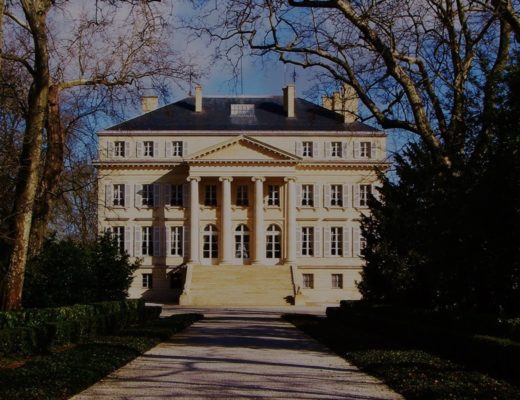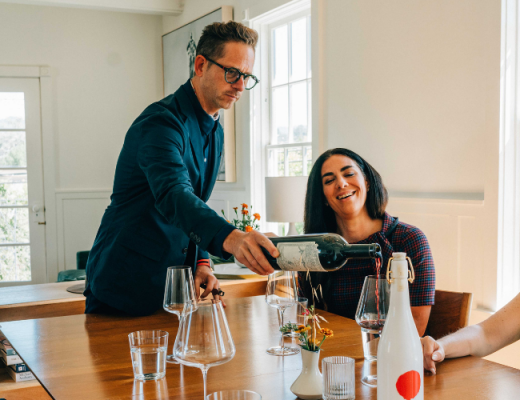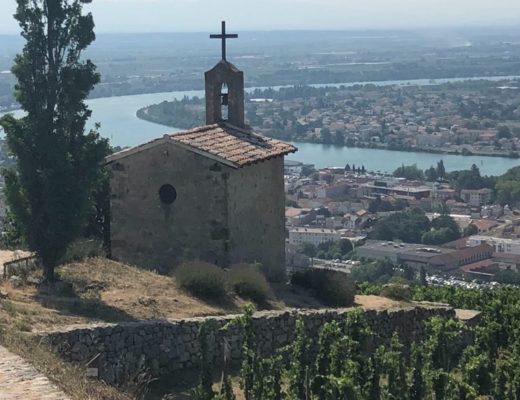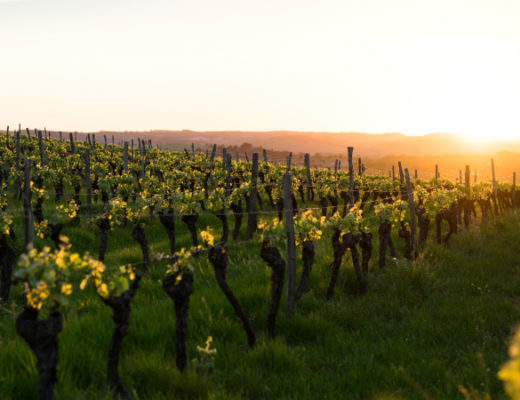As harvest was winding own in Napa, we headed back to the ancestral home of Cabernet Sauvignon this fall to see how the vines (and vintners) were faring after Bordeaux’s warm summer season. As grapes were landing on the sorting table from Sauternes to Pauillac, we heard two messages on repeat: “Thank God it rained,” and “2019 is great.”
When we arrived, we found that and more in the medieval churches,18th-century châteaux, and alongside the Gironde river itself in a combination that showcased why Bordeaux is one of our favorite places to visit.
Day One: Fusing Tradition & Modernity in Downtown Bordeaux
The jet lag from California to Europe is notorious. After decades of being on the wine trail, we know the trick to beating fatigue is wine and sunshine—and Bordeaux in early fall has both in spades. Inspired by the Gironde river, which stretches from the bustling city of Bordeaux to the ocean, lending its influence to each appellation in the sprawling region, we walked the banks of the river, passing by the original merchant houses that made Bordeaux a global wine power hundreds of years ago.
Every time we pick up the newspaper, we’re reading about mergers and acquisitions, but when it comes to Bordeaux past and present “marriages and acquisitions” is more apt. Bordeaux owes its legacy to Eleanor of Aquitaine, the fondly named “First Cougar of France,” whose marriage to the English King Henry Plantagenet made Bordeaux an English colony in 1152.
The short version of what followed, and solidified Bordeaux as both wealthy trading center and England’s go-to red wine supplier is this: Under English rule, Bordelaise wine merchants were exempt from heavy taxes on wine, and thus were able to ship their bottles to England at the best prices. After a few hundred years of cementing their status as top quality and top value producers, The Hundred Years War obliterated their trade routes but eventually, French kings (and their signature tax codes) conceded and the Bordelaise returned to sending wine to the British. Ready to expand their influence, profitable trade routes with the Dutch solidified Bordeaux’s powerhouse status.
Today, you can still see hints of the glory days in Bordeaux because the original towering wine merchant houses still sit, overlooking the riverbanks But don’t make the mistake of thinking Bordeaux city is stuck in the past—today it’s a modern, bustling, and multicultural metropolis. We discovered the city’s vibrant dining culture at Les Halles de Bacalan, where everything from Bordelaise classics like foie gras and fresh seafood rillettes to Moroccan delicacies were on offer.
Unable to resist a pairing challenge, we did a circuit of the place and reunited with a smorgasbord including classic serrano ham and manchego croquettes, Arcachon oysters on the half shell, fish rillettes, truffled cheese, Moroccan beef Briouats (the bedouin version of egg rolls), and a salad for good measure. Naturally, there was wine.
Across the board, classic clarets like Château Lafont Amour À Nos Amours and Château Potensac were perfect pairings—which surprised even us, given the range of flavors on the table. These reds have all the bright red fruit and oak spice you could want but their structure and acidity make them ideal pairings across a range of foods, proving these wines shouldn’t be limited to bistro-style French dishes becase they are better than most New World Cabernets with modern cuisine.
Our bellies full, we bypassed the river on our way back to our hotel at the Place Opéra and made a detour to hit Aux Quatres Coins du Vin, our favorite bar in the bustling St. Pierre district. Tucked on a pedestrian-only street, the bar serves over 50 wines by the glass and the bartenders always know what’s hot in the neighborhood—so we make it a point to start our trips there.
This time, the Tennessee native behind the bar cut right to the chase: “If you’re looking for natural wine, you should head out of Bordeaux because that trend doesn’t exist here,” he said when we mentioned being from California. “But this season is shaping up great.”
We toasted to that early indicator of what our trip might hold, and for the previews of the 2019 season we’d hopefully be tasting the next day.
Day Two: Saving the Best for First
We got up early and headed out from the still-sleepy Bordeaux centre and zipped along the Gironde to Pauillac, home to Château Latour, Château Mouton-Rothschild, Château Lafite-Rothschild, and countless other classed-growth estates.
After driving past seemingly endless rows of vineyards, dotted with early morning pickers and tractors overflowing with grapes we arrived at our first stop: 5th Growth Estate Château Haut-Batailley, a jewel in Pauillac and the latest property to fall under Château Lynch Bages empire.
Inside the 18th century building, two sorting tables were staffed with six people each, sorting out everything but the most perfect Cabernet Sauvignon during one of the estate’s final picks of the year.
Here, Cabernet Sauvignon dominates the plantings on stony, gravelly soils and Merlot plays a small, supporting role. Approaching the end of harvest on October 5th, the estate was bustling and the grapes were “perfect,” according to their winemaker who expects a fantastic showing…but wasn’t quite ready to let us taste the newly fermenting wine. The bright purple juice, fresh off the press, was all we needed: It was incredibly sweet, but balanced with a zingy, tart acidity that hinted to 100-point potential.
Then we headed to Château Lynch Bages, where the entire harvest team of 50 people was in the dining hall, being served good, soul-warming home cooking alongside the Cazes family that has shepherded this estate to international stardom in the past generation. Inside the bustling hall is warm and smells delicious, and there’s wine on every table alongside steaming piles of chicken, huge salads, crispy french fries and baguettes being ripped and passed down to the next diner. The feeling of teamwork and synergy was palpable, especially as patriarch André Cazes moves from table to table chatting with workers, many of whom have made their careers here.
And when you taste the wine, it’s no wonder: Lynch Bage’s silken red is the definition of multi-layered, combining ripe plum and blackberry fruit with fresh herbs like sage, rosemary, and thyme before revealing stony minerality. Its fine-grained tannins made the jovial, bustling dining hall disappear for a few moments as we sank into the wine.
Marina Cazes, André’s daughter who now runs the estate with her brother, also treated us to a sample of the 2005 Lynch Bages. If you’ve got this in your cellar, it still has plenty of life left to live. Fresh red fruit aromas of cherry and red currant mingled with fine leather, pipe tobacco, cedar, and whole toasted baking spices before a gentle segue into a long finish guided by fine, cashmere tannins. In person, Lynch Bages more than lives up to its reputation, and that reputation is only poised to grow with the 2019 vintage.
Marina couldn’t wait to tell us about the 2019 harvest. “It’s great,” she said without hesitation. “We have nice volume, quality, and the perfect conditions.”
With visions of Lynch Bages dancing in our heads, we returned to Bordeaux knowing the top growths won’t disappoint in the 2019 vintage.
Day Three: From Botrytis to Barrel Samples (or Into the Wild!)
It was now time to go beyond the towering Châteaux of the Haut Médoc in one of our favorite rituals of visiting any region: sussing out the best producers in less-known (and hot value) areas. In Bordeaux, that means visiting appellations like Graves, Lalande-de-Pomerol, and top producers on the fringes of the region like Bordeaux Supérieur and the Côte des Francs.
Our first stop was in Graves, where fog clung to the vines on the brisk and dreary October morning. Here, at Château de Castres we encountered 8th generation winemaker Léa Lalande Rodrigues overseeing a final Cabernet Sauvignon harvest.
The grapes were juicy and absolutely delicious when we sampled them standing amongst the rows on a bed of gravel and clay soils. “We are really happy this year,” explained Léa, as we watched the grapes being towed toward the ancient stone winery in the distance. “After the heatwave, the rain came at just the right time to keep the quality high.”
It was music to our ears. When temperatures rise to extreme levels, grapevines (and other plants) stop respiration to conserve energy and water. If the heat doesn’t wane young grape clusters can wither and die on the vine, leading to a devastating harvest in September or October. In the case of Graves and Bordeaux at large, Mother Nature provided just enough rain after the July heatwaves to keep the vines comfortable, without providing too much moisture.
Inside, we sampled the Château de Castres and may have found a new favorite producer—the wines were ruby-crimson and the definition of vin de soif, or thirst-quenching wine, which blended red and blackberry fruit with medium tannins and a charming, rustic finish.
Next, we drove through the countryside to Château Pudris, a biodynamic site where the winemaker Mathieu Huguet is making his first vintage at the estate under his new label. The sun has come out, and opened up onto a scene of Mathieu and his family and friends harvesting Merlot and Cab Franc from their vineyards, which sit on limestone soils. These soils allow for excellent drainage, which helps the vines stay in balance throughout the season.
The scene is straight from a fairytale: Kids are running around playing tag and picking grapes. A horse pulls a wagon with bins overflowing with the harves, dogs play, and birds are chirping. Walking through the unmowed grass, blue blossoms are popping out from between the clovers. Mathieu and his wife together form this label and the wines are fruit-driven and pure, with herbal undertones and just enough minerality. They remind us of our Bordeaux favorites like Croix de Labrie’s Camille de Labrie and Château Marsau—full-bodied and layered with flavor, they’re easy to love and easy on the wallet.
Snapped out of our reverie by the setting sun, we headed back to Bordeaux to unwind.
Day Four: Feeling Sweet about Harvest
As we drove into the countryside from Bordeaux, the sun was beginning to burn through the thick fog, creating the perfect conditions for botrytis, the famed noble rot behind Bordeaux’s legendary dessert wines. It was also making our mouths water, since we were heading toward Sauternes and Château Rayne-Vigneau to see how the region’s dessert wines were coming along in tandem with the reds.
It was fully sunny when we reached their Château, and we could see Château d’Yquem in the distance. In between the vines we saw the slightly shriveled grape bunches, which looked to be covered in dust. That dust, as it turns out, is the cherished Noble Rot that gives Sauternes wines their distinctive honey flavors. Tasted fresh off the vine, botrytized grapes (in this case, Semillon) are the best raisins you’ve ever tasted. Seriously, if the average golden raisin had this type of honeyed, candied flavor everyone would opt for raisin cookies over chocolate chip ones.
Our guide explains to us that Sauternes isn’t just about balancing sweetness with acidity, but about balancing sweetness, acidity, and saltiness which is lent to grapes from their terroir. Here at Rayne-Vigneau, they look to balance all three by picking the grapes in multiple passes, and fermenting each lot separately so that the final blends are perfectly balanced. The result is wines that delightful to drink in their youth or after time in bottle—and need not be limited to dessert courses. This year, the conditions for botrytis were ideal, allowing Rayne Vigneau to produce their full range of Sauternes wines.
Walking away from the hillsides where white grapes were being picked berry by berry, destined for the airport we were sad to be leaving Bordeaux. But knowing the quality level of the 2019 harvest, we knew we weren’t saying goodbye to this terroir or these specific grapes. Instead, we were just saying, “See you later.”





